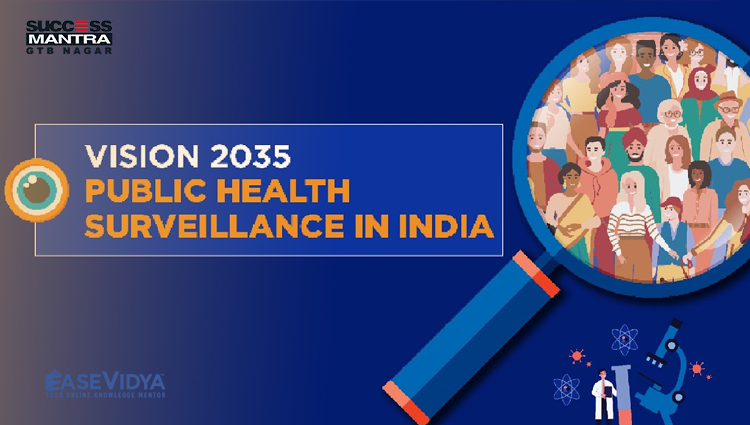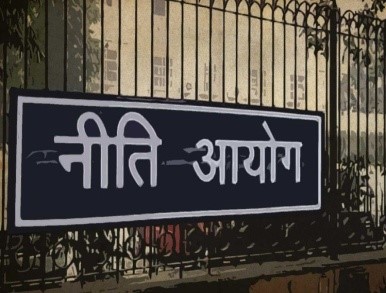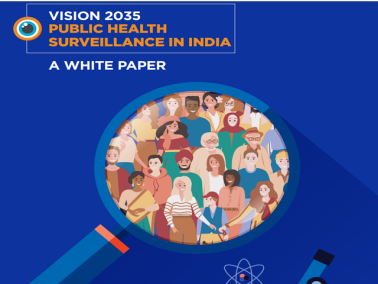
VISION 2035 PUBLIC HEALTH SURVEILLANCE
VISION 2035: PUBLIC HEALTH SURVEILLANCE IN INDIA

Recently, the NITI Aayog has released a white paper, “Vision 2035: Public Health Surveillance in India” which is envisaged to serve as a vision document to propel Public Health Surveillance (PHS) in India and establish India as a global leader in the area. A white paper is an informational document, usually issued by a company or not-for-profit organization, to promote or highlight the features of a solution, product, or service.
NITI Aayog’s mandate is to provide strategic directions to the various sectors of the Indian economy. In line with this mandate, the Health Vertical released a set of four working-papers compiled in a volume entitled ‘Health Systems for New India: Building Blocks-Potential Pathways to Reforms’ during November 2019. This white paper is a continuation of the work on strengthening the health systems.
WHAT IS WHITE PAPER BY NITI AAYOG?
This paper is a joint effort of Health Vertical, NITI Aayog, and Institute for Global Public Health, University of Manitoba, Canada with contributions from technical experts from the Government of India, States, and International agencies. It lays out India’s vision 2035 for PHS through the integration of the three-tiered (primary, secondary and tertiary) public health system into Ayushman Bharat. It contributes by suggesting mainstreaming of surveillance by making individual electronic health records the basis for surveillance.
MAIN CHARACTERISTICS & FEATURES

• Strengthen non-communicable disease prevention, detection, control and to reduce out of pocket expenses of individuals and families. It builds on initiatives such as the Integrated Health Information Platform of the Integrated Disease Surveillance Program. Aligns with the citizen-centricity highlighted in the National Health Policy 2017 and the National Digital Health Blueprint. It encourages the use of mobile and digital platforms and point of care devices and diagnostics for amalgamation of data capture and analyses. It highlights the importance of capitalizing on initiatives such as the Clinical Establishments (Registration and Regulation) Act 2010 to enhance private sector involvement in surveillance. It points out the importance of a cohesive and coordinated effort of apex institutions including the National Centre for Disease Control, the Indian Council of Medical Research (ICMR), and others.
• Vision: To make India’s PHS system more responsive and predictive to enhance preparedness for action at all levels. To make it more citizen-friendly to ensure individual privacy and confidentiality, enabled with a client feedback mechanism. To improve data-sharing mechanisms between Centre and states for better disease detection, prevention, and control. To provide regional and global leadership in managing events that constitutes a public health emergency of international concern.
PUBLIC HEALTH SURVEILLANCE (PHS)
PHS is an important public health function that cuts across the three-tiered public health system and care provided. Surveillance is ‘Information for Action’ and is an essential action for disease detection, prevention, and control.
CHALLENGES ASSOCIATED WITH IT
• Data Collection and Sharing: Various verticals to collect data work differently and in separation with no mechanism for data sharing. There is no single system where surveillance data generated by target specific populations like the National AIDS Control Programme, National TB Elimination Programme, etc. could be understood in its entirety.
• Poor Quality Data: The data generated is of low quality and the research or use of data to answer critical health policy questions of the country has been very limited.
• Limited Synchronisation: There is the limited ability of programme implementation structures to work in synchrony with research organisations and vice versa.
• Missing Linkages: India invests significant resources in the registration of deaths. However, various reviews have not been able to link the causes of mortality with morbidities. There was still no proper linking to find common ground between the causes of diseases and deaths.
• Lack of Human Resources: Human resources also form a formidable challenge. As many as 42% vacancies existed at state and district level surveillance systems. Most of the positions of the Central Surveillance Unit at the Centre are filled either by deputation or on contract and the individuals are loaded with multiple other responsibilities.
• Lack of Epidemic Intelligence: India does not have an adequate number of public health professionals having expertise in the field. ‘Epidemic intelligence’ can be defined as all the activities related to early identification of potential health threats, their verification, assessment and investigation in order to recommend public health measures to control them.
• Under-developed Systems: A non-communicable diseases (NCDs) surveillance system hardly exists in India and other factors like integration of surveillance for NCD risk factors, surveillance of injury and accidents, air pollution and its effects, etc, are yet to be included in surveillance.
• Lack of Occupational Health Surveillance: This type of surveillance addresses issues like lead toxicity, silicosis, etc. Whatever data has been generated hardly became part of India’s PHS system.
• Emerging Challenges: Growing antimicrobial resistance (AMR), new infectious diseases or new strains of existing diseases and increased rate of NCDs.
CONCLUSION

• Creation of a skilled and strong health workforce dedicated to surveillance activities. Integration of NCDs, reproductive and child health, occupational and environmental health and injury into PHS.
• Merger of morbidity data from health information systems. Amalgamation of plant, animal, and environmental surveillance in a One-Health approach that also includes surveillance for antimicrobial resistance and predictive capability for pandemics. Strengthening of laboratory capacity with new diagnostic technologies including molecular diagnostics, genotyping, and phenotyping.
• Establishment of a governance framework that is inclusive of political, policy, technical, and managerial leadership at the national and state level. Enhancement of surveillance of NCDs, citizen-centric and community-based surveillance and use of point of care devices and self-care diagnostics. Prioritization of diseases that can be targeted for elimination as a public health problem, regularly.
• Improvement of core support functions and system attributes for surveillance at all levels. Establishment of mechanisms to streamline data sharing, capture, analysis, and dissemination for action. These could include the use of situation-aware real-time signals from social media, mobile sensor networks, and participatory surveillance systems for event-based epidemic intelligence. Encouragement of innovations at every step-in surveillance activity.
QUESTIONS (1-5)
Q.1 Recently, NITI Aayog has released the white paper which is titled by which of the following names?
A. Vision 2030: Public Health Surveillance
B. Vision 2030: Public Welfare Watchlist
C. Vision 2035: Public Health Surveillance: ANSWER
D. Vision 2035: Public Welfare Watchlist
Q.2 The white paper which is released by NITI Aayog is a joint offer of which of the following?
A. NITI Aayog
B. Institute for Global Public Health
C. University of Manitoba, Canada
D. All of the above: ANSWER
Q.3 Which of the following statements is/are incorrect about India's 2035 vision of Public Health Surveillance?
A. It Strengthens non-communicable disease prevention, detection & control.
B. PHS is an important public health function that cuts across the five-tiered public health system: ANSWER
C. To enhance preparedness for action at all levels.
D. None of the above
Q.4 NITI Aayog (National Institution for Transforming India) which is a policy think tank of Government of India replaces which of the following commission earlier?
A. Planning Commission: ANSWER
B. Finance Commission
C. Law Commission
D. Human Rights Commission
Q.5 Which of the following also holds the chairmanship of the NITI Aayog?
A. Finance Minister of India
B. Prime Minister of India: ANSWER
C. Minister of Education
D. Comptroller and Auditor General












0 Comment